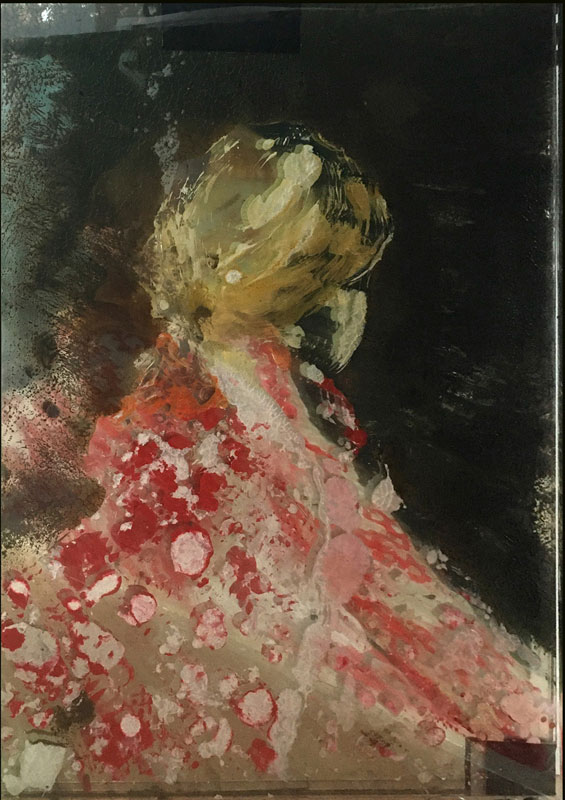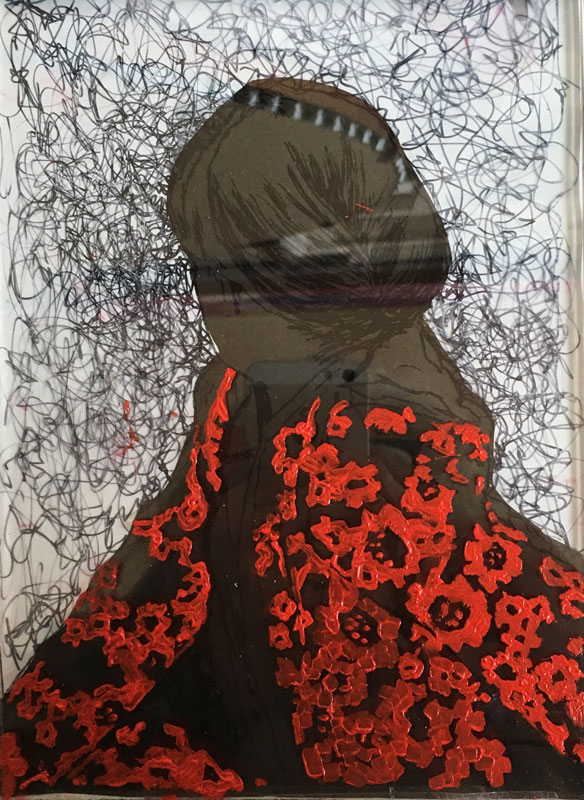Betty: in search of essence
Thinking Gerhard Richter’s painting of his daughter Betty whom he’d photographed…counter intuitively with her face turned away towards a dark background.
Investigating Richter’s provocation: paint copy of Betty in oil on the reverse side of a glass panel (feeling being that the first paint applied might reveal a truer picture of what lay behind Betty’s gaze)
Apply glass pane to the wet paint and take print.
‘Betty’, now reversed and looking as if she is viewed from the perspective of her dark background, breaks! No matter, use gaffa tape, and place on delaminating mirror – her background now reflecting back on us.
Apply yet another clear pane; another clear layer to clarify… or Richter-like, to deprive the viewer again of what they had hoped would be revealed perhaps?
Full Artist Statement
Gerhard Richter’s unusual painting of his daughter “Betty” in 1988 is more than a deliberate provocation.
Richter commonly paints from photographs and close observation of this image reveals that he has not deviated from his MO. Here he has first photographed “Betty” (or Babette to him) in what is likely a studio given the dark background, the white bench on which she sits, and with a large format camera perhaps that captures the extremely shallow depth of field. Only her most forward shoulder is in sharp focus while what is behind increasingly out of focus giving the appearance of receding, memory-like. There is much more to remark upon in this metaphorically rich image (a young white girl, her peculiar style of braided hair, volk-like costume, all ‘Germanic’ signifiers perhaps) but suffice to say for my purposes, it is a very carefully crafted image and no ‘snapshot’.
Of course the most overarching element of this image is that Richter has, counter-intuitively from our point of view, chosen to photograph his young daughter with her head turned sharply away from the camera and facing that dark background. Why, one is compelled to ask, has Richter chosen this image of his subject to anchor and elevate in oils? Is he suggesting she might be looking back into that darkness as if looking back in time, contemplating Germany’s recent history say? All those interpretations are possible.
An alternative view.
What is behind our expectation in seeing her face? I suggest we would presume to gain some private or personal information, or feel we would learn something of Betty from her facial expression.
And it is for this very reason that I suggest that Richter has chosen to deny us that titillation because he believes that whatever we believe we can take from our gaze will be mere presumption, or a figure of our imagination – either way it would be inherently make-believe.
I further suggest that by Richter’s action he not only denies us the ability to make such presumptions but he understands and is telling us that our view of a figurative image, no matter how beautifully or accurately rendered, our personification of it, will never, indeed cannot ever reveal the essence of the subject matter – something that even he as her father is not privy to and something that will remain Betty’s always. The essence of Betty as a person in incommunicable – though I believe he acutely recognizes that our creative imagination remains brutally alive.
Richter’s ‘Birkinau’ (2014)
In my view, these observations shed some light on why Richter chose to fulfill his ‘Birkinau’ commission the way he did. His, and perhaps our understanding is that the unimaginable horror of the subject matter could not ever be truly conveyed nor justice done to it via a painting.
The four photographs inside the camp, taken in secret by a Jewish prisoner that were provided to Richter when he was commissioned and upon which he literally albeit initially, based his paintings, certainly depict the brutal factual truth of the mass murder. But perhaps they do not tell of the ‘mountain range’ of human grief and suffering involved, and the intergenerational trauma it has imparted since that time. Its legacy is complex, far-reaching and global.
In many respects the subject is so mammoth, and so truly ineffable it presents to Richter a quandary for in many respects it is unpaintable.
In my view Richter has chosen a strategy relatable to that he applied in ‘Betty’. As purposely as he set up the photograph of Betty, Richter chooses to deny the viewer the photographic-like image (that supposedly lies beneath the paint – barely discernable if at all).
By so doing he denies the viewer the titillation of the pornographic view. That is, the hyper-real view that promises so much but delivers so little. (And dare I say in these times many images of the holocaust have become hackneyed. We are want to cast our eyes away too quickly and without too much consideration of their import.)
In addition, and perhaps more importantly, we cannot rest on the presumed veracity of the realistic image to provide the essence of the horror depicted. Richter’s strategy is to deny any satisfaction in any feeling by the viewer that they have gleaned the essence of the horror. He requires more of the viewer. By these means I consider he articulates all the better the indescribable horror that lies behind those photographs of a mountain of human corpses.
Nov. 2019
.
.
Betty: in search of essence – in the studio: A postscript written about a studio exercise undertaken before I could articulate the above.
I approached this investigation somewhat naively and thinking to discover what Betty was looking at over her shoulder I took to painting her image from behind.
Taking a pane of glass I copied her image with a view that I would look at the resulting image through the glass thereby revealing the first unchangeable stroke of the brush – the first layer of paint that is applied, not the last.
Betty remained silent.
I pressed another pane onto the wet surface and pried it off. Now Betty, reversed – as if we are looking from behind her.
Still she is silent.
I placed a mirror behind her to reflect back her image. No hiding this time…?
She remained hidden albeit we were reflected back twixt her image; merged in part, obfuscated, I see in her part of myself. The picture clears a little.
Returning to the search for essence. Richter tells me I will never find it. Indeed Richter’s abstraction of Betty (for that is what it is effectively although it wouldn’t matter if it were real as Zeuxis’ birds or Parrhasius’ curtains) does not permit me to pretend to find it. He tells us that the very essence is never revealed. No matter how literal or abstract, the essence of our selves, our experiences, our histories is not ever truly communicated and it is a deception we’d inflict upon ourselves if we considered it otherwise.
But I feel I better understand Richter’s approach to his “Birkinau” images – knowing that I ought not be deceived by any literal or ‘realistic’ view purporting to cover the essence of the subject matter. Instead, his images, abstracted in the extreme, openly recognize the complexities of its subject, of the indescribable, of the truly ineffable horror of the genocide.
….
It is not a stretch I think to see how all this might apply to the fundamentalist. If you see the Buddha on the road – you have not seen him, for the full truth has not been revealed to you nor to anyone else as it cannot ever be! So kill him quick! And think again.


